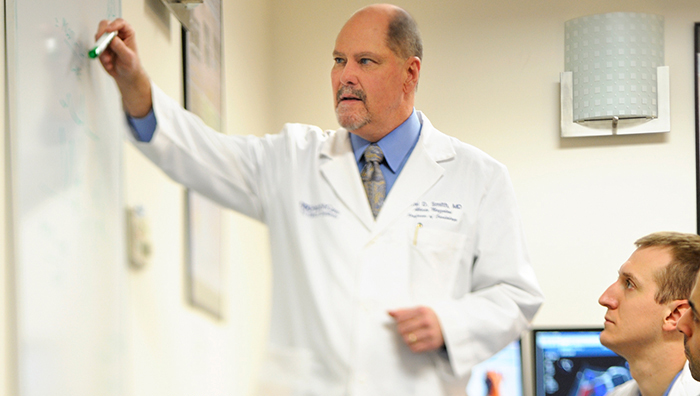Echocardiography is Much More Than Just "Taking Pictures"
It wasn't so long ago that the only imaging available to physicians was an X-ray. How times have changed.
The term "imaging" now applies to any number of procedures, including MRI, CT scans, sonography, and echocardiography, all of which help physicians diagnose patient illnesses non-invasively.
As director of the echocardiography lab at the University of Kentucky's Gill Heart Institute, Dr. Mikel Smith excels at the latter. "We like to joke that we take pictures for a living," Dr. Smith says of himself and his team.
"Of course there are M.D.s, but the team is much broader than that," Dr. Smith says. "From the clerks who check our patients in, to the techs, the nurses, and the sonographers — their skill, their experience, and the friendly enthusiasm for their profession and their patients — all of that is a meaningful part of the effort we bring on behalf of our patients."
Smith remembers the first time he saw an echocardiogram underway.
"I was hooked. To be able to see the heart beating, the heart structures, just by squeezing some gel on a patient's chest and without hurting the patient at all — that was amazing."
Imaging is the backbone of patient care today, and echocardiography (ECHO) has matured far beyond its original purpose as a diagnostic tool. ECHO now plays a role in patient diagnosis, treatment, and performance metrics, especially in cardiology. Smith ticks them off on his fingers.
"An ECHO can diagnose heart valve issues," he says. "Then ECHO can be used to help determine the exact placement of a new valve during a procedure to replace the diseased one. Afterwards, ECHO is used to assess how well that new valve is functioning."
Dr. Smith and Annette Smith, have helped create the region’s most advanced ECHO lab, dedicating literally thousands of hours to training technical and medical staff at this complex tool.
According to Annette, who manages the ECHO lab, the Gill Heart Institute has historically been at the forefront of advancements in cardiac imaging. Gill has participated in early clinical research on nearly all of the new imaging technologies, including color Doppler, spectral Doppler, stress ECHO, trans-esophageal ECHO, and 3D ECHO. And, since Gill went digital in 2004, the skills and expertise that Annette, Dr. Smith, and the rest of the imaging team bring to the table are accessible beyond 800 South Limestone.
UK HealthCare's aim has long been to treat patients as close to home as possible, bringing only the sickest to Lexington, and offering the latest and best treatments so that they don't have to leave Kentucky at all for their healthcare. For imaging, that means patients are able to get their scans out in the state, but have them read in Lexington.
Annette says that sounds easier than it really is, but Gill has exceeded its own expectations by approaching each element thoughtfully.
First: experience.
Gill's ECHO Lab has been continuously accredited by the ICAEL since 1999. Only a handful of labs in the country can make that claim.
Cardiology fellows at the Gill are encouraged to take the NBE (National Board of Echocardiography) exam, which is notorious for its difficulty. Nonetheless, every Gill fellow who has taken the exam in the past 10 years has passed.
Dr. Smith and one of his colleagues, Dr. Vincent Sorrell, have been awarded the American Society of Echocardiography's Richard Popp Excellence in Teaching Award, which recognizes the important role of teaching and mentorship in echocardiography. There have been 14 Popp awardees thus far -- and Gill claims two of them.
Of course, physicians are only part of the story: high-quality imaging starts with experienced sonographers.
"We have 129 combined years of cardiac sonographer experience," Annette says proudly. And all Gill sonographers are required to pass the certification exam from the American Registry of Diagnostic Medical Sonographers (ARDMS).
"Most hospitals don't require that, but we want our staff to reflect the highest levels of expertise," Annette Smith says.
Second: training.
"We've worked with sonographers around the state, helping them evaluate their equipment and improve their skills so that their imaging studies are top-notch," Annette says. "Last fall we even offered a weekend symposium so that the sonographers off site would have face-to-face time with our docs and hands on training performing ECHOs side by side with our team on real people."
"By doing so, these sonographers develop confidence in their skills and their ability to deliver high-quality image studies," Annette explains.
Those studies may be sent to UK via the cloud and are read as part of the daily schedule, with interpretations immediately available as if the doctors were on-site at the local facility.
"It is common for us to read a study from the UK outpatient clinic, the UK ICU, the Good Sam ICU, the Hazard outpatient clinic, the Good Sam outpatient clinic, and other outreach locations back to back to back," says Dr. Smith.
This outreach to provide guidance and training to echo labs around the state is the proverbial "tide that lifts all boats" -- quality is improved everywhere, to the ultimate benefit of the patient.
And the technology continues to advance. Dr. Smith has a hand-held device that enables him to perform echocardiograms at a patient's bedside, making diagnoses even faster and more accessible.
"Some people think these will replace the stethoscope," Dr. Smith says with a chuckle. "While I can't envision that, exactly, I can say that the ability to facilitate better access to ECHO, procure the highest quality images, and interpret those images quickly culminates in the best possible outcome for our patients."
